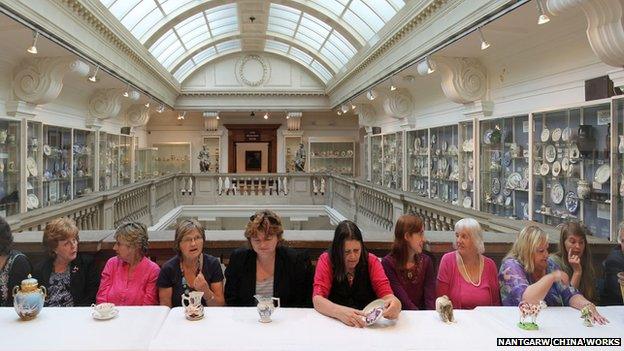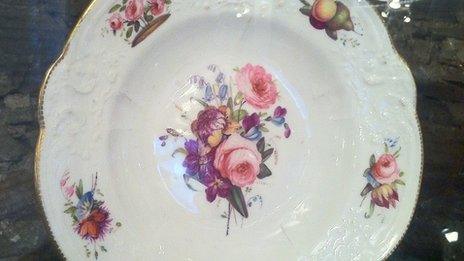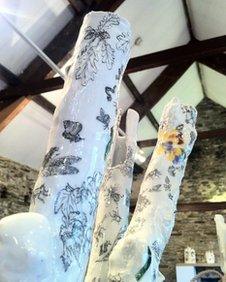Nantgarw China Works celebrated in exhibition
- Published

The Nantgarw China Works exhibition examines the impact of artist and founder William Billingsley - and modern contemporary works
A 200-year-old story of artistic brilliance, industrial espionage, and bankruptcy is celebrated with a new exhibition in the south Wales valleys.
The show examines the work of William Billingsley, founder of the Nantgarw China Works and a known perfectionist.
The bicentenary exhibition features rare examples of the works' output, alongside items created by some of Wales' foremost contemporary potters.
Billingsley fled Wales in 1820, pursued by creditors.
But his work is still regarded as some of the finest ceramics ever produced - a single piece can fetch tens of thousands of pounds at auction.
One of the reasons is the rarity of Nantgarw chinaware - the artist was regarded as a complete perfectionist, rejecting 90% of everything he ever made.
His pieces were deemed so exquisite that fearful Staffordshire potteries ganged up in an attempt to put Nantgarw out of business.
Founded in 1813 on the banks of the Glamorgan Canal, it was also claimed that the clay formula Billingsley used was stolen from Royal Worcester.
'Hopeless businessman'
But in just seven years, despite being regarded as the finest ceramicist in Britain, Billingsley had racked up crippling debts and quit the Nantgarw works.
"Nantgarw China Works is such a thrilling story that it really should be made into a film," enthused Lowri Davies, who has organised the exhibition.

One of the original - and very rare - Billingsley plates at the Nantgarw museum
Her own Billingsley-inspired collection featured at the Sculpture Objects and Functional Art exhibition in Chicago, USA.
"It's the tale of a man so driven to perfect his art that nothing else mattered," she added.
"He was a hopeless businessman who was always in some scrape or other, constantly being sued and pursued by creditors, but as long as his pieces were the best the world had ever seen then he didn't care about little things like intellectual property or even making money.
"And his work was brilliant - exquisite wet paste china and instantly recognisable, breathtaking floral artwork."
After Billingsley left Wales in 1820, his business partner William Western-Young managed to stave off formal bankruptcy by selling Billingsley's remaining work, which had acquired an increased value following news of the demise of Nantgarw China Works.

One of the new pieces at the exhibition by Cardiff artist Mick Flynn
Western-Young kept the factory open, but without Billingsley's expertise they were reduced to manufacturing clay smoking pipes and rough earthenware pots and jugs.
This proved to be infinitely more profitable, and the works went on to survive until 1920, when the switch away from pipes to cigarettes was the death knell for the business.
But despite a hundred years of pipe manufacturing, according to Lowri Davies it will always be their fine china for which Nantgarw China Works will be best remembered.
"In some ways it's a tragedy that Nantgarw China lasted such a short time, but then again, if it had gone on for decades or even centuries, then would we be talking about it today?"
The china works near Caerphilly lay derelict for decades until it was acquired by the former Taff-Ely council in the 1980s and was turned into a museum.
Earlier this year Rhondda Cynon Taf council handed over the museum to the Friends of Nantgarw China Works Trust, who are now undertaking an extensive restoration of the original studios and kilns.
Amongst others, the exhibition at the works museum features craftwork from Caitlin Jenkins, of Ewenny Pottery, and Geoff Swindell of Dinas Powys, whose creations are included in the collections of some 40 museums including the Victoria & Albert in London.
The exhibition runs at the museum until 12 January, 2014.
- Published26 May 2013